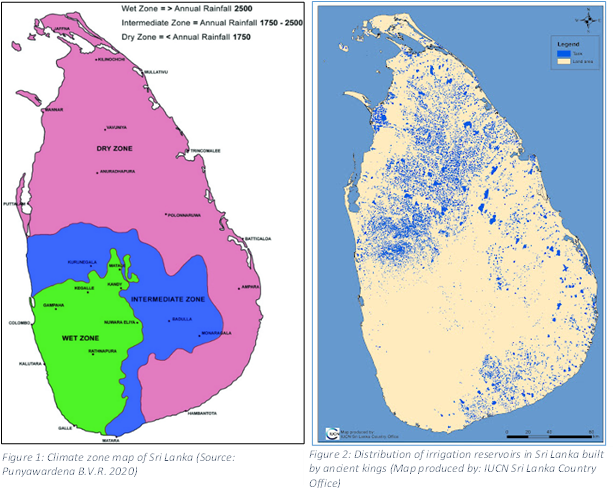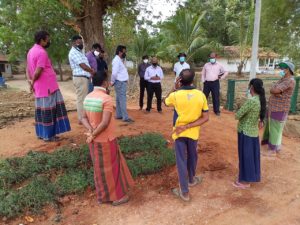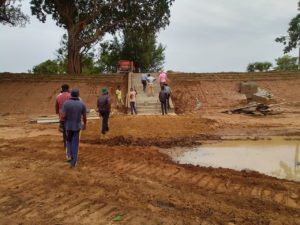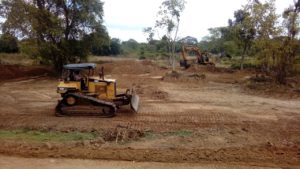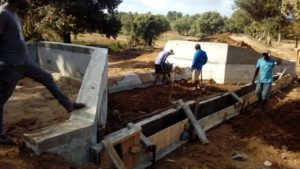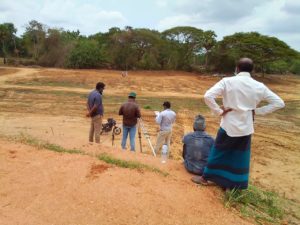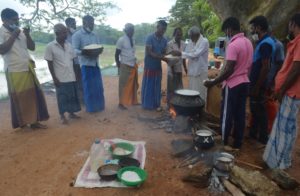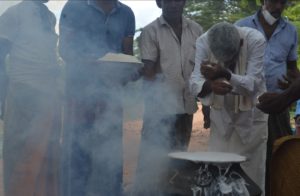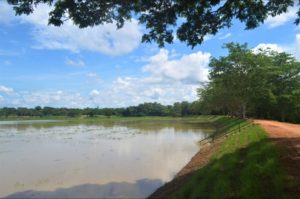Adaptation to Changing Rainfall Patterns: Rainwater Harvesting Through Irrigation Reservoirs
by Sakshi Selvanathan and Ganga Kariyawasam (22nd November 2021)
At present, the effect of climate change is quite significant in the dry zone of Sri Lanka, where agriculture is one of the main livelihoods of the rural communities. As a tropical country, Sri Lanka gets seasonal rainfall with a dry spell of less or no rain for nearly six months of the year in the dry zone. The dry zone receives a mean annual rainfall of less than 1,750 mm with a distinct dry season from May to September (Figure 1). Although, the annual rainfall is constant throughout the years, the distribution during the year varies due to changing rainfall patterns – this is mainly by receiving high-intensity rain during few months of the year, resulting in unexpected floods and droughts. Those who engage in traditional rain-fed farming and depend on minor irrigation reservoirs[1] for irrigation water are severely affected due to the unavailability of water in the expected time period and in required volume. Thus, the production and supply of most of the crops grown by those farmers, including paddy, Other Field Crops (OFCs) and low country vegetables which largely contribute to the staple food of Sri Lankans, are disturbed.
As a remedial measure to provide a year-round food supply with seasonal rainfall, the ancient kings built minor irrigation reservoirs or village irrigation systems in the dry zone (Figure 2), to collect and retain water during the rainy season and to use during the dry season. This water management system was successfully practiced for agriculture in ancient times with state sponsorship. But with colonization and un-planned development activities afterwards, minor reservoirs and village irrigation systems collapsed. And since then, very few efforts have been taken to restore the systems. But if it is done on a wider scale, it would provide greater climate change adaptation solutions to reduce the impact of climate change in the dry zone of Sri Lanka.
It is situations such as these that the Climate Resilient Integrated Water Management Project (CRIWMP), locally known as ‘Wew Gam Pubuduwa’, aim to provide solutions for. The project commenced in 2017, aiming to strengthen the resilience of smallholder farmers in the dry zone to climate variability and extreme events through improved water management. The ‘upgrading of village irrigation systems’ is one of the main components of the project, and with the lessons of similar interventions carried out in the past few years, the project commenced an upgrading of 16 minor irrigation reservoirs in Kadawala cascade[2] in the Mee Oya River Basin in April 2021. This is located in Katuwewa and the Peddogama Grama Niladhari (GN)[3] Divisions, in Galgamuwa Divisional Secretariat Division within the Kurunegala District.
As the partner Civil Society Organization (CSO) in the project in Kurunegala district, the Sri Lanka Red Cross Society (SLRCS) mobilized the community since the inception of the project to ensure meaningful participation with established good governance, and the improvement of transparency, responsiveness and accountability. During the process, systems were established for the active engagement of community members through Participatory Monitoring Committees (PMCs) and the necessary capacities of Farmer Organizations (FOs) for monitoring of irrigation development works were built. Farmers gathered knowledge and skills through trainings such as construction supervision, operations and maintenance of village irrigation systems, and they were further strengthened through exposure visits/ cross learning visits to previously rehabilitated cascades in the district. Moreover, SLRCS engaged in planning and implementing of the intervention in coordination with the Government and other partners involved in the project.
Hence, the upgrading of 16 minor irrigation reservoirs in the Kadawala cascade has been planned, implemented and now completed together with the FOs representing the user communities of the area. Furthermore, ecosystem development has also been promoted in all the irrigation reservoirs in the cascade with participatory social demarcation of Kattakaduwa[4] and tree planting. And in order to symbolize the completion of construction and to obtain blessings for agriculture activities before starting the cultivation of Maha season, the traditional inauguration rituals were done this month.
A total of 1,460 persons (667 men & 793 women in 531 families) benefit at present from this intervention. This is an outcome of a great team effort of FOs, Ministry of Irrigation, Provincial Department of Irrigation – North Western Province, Agrarian Services Center (ASC) – Galgamuwa of Department of Agrarian Development (DoAD), Galgamuwa Divisional Secretariat, United Nations Development Program (UNDP), SLRCS and contractors. And so the SLRCS, as the community mobilization and coordination agency, assured the support and cooperation of all stakeholders during the implementation of this meaningful intervention through effective collaboration and coordination.
About the CRIWMP or Wew Gam Pubuduwa:
The SLRCS mobilizes farmer communities in the dry zone to adapt climate resilient agricultural activities. The CRIWMP is a 7-year project started in 2017, aimed at strengthening the resilience of Smallholder Farmers in Sri Lanka’s Dry Zone to unpredictable climate variability and extreme events.
The Project is financed through a grant received from Green Climate Fund (GCF) while the Government of Sri Lanka has committed to co-finance the activities identified under the Project as well. Ministry of Irrigation, is an implementing partner for this project, with technical assistance of the United Nations Development Program (UNDP) and work with a number of government institutions to deliver the project activities and outputs while measuring its’ impact.
[1] Minor reservoirs or small tanks in Sri Lanka are those having an irrigated command area of 80 ha (1 ha = 2.47 acres) or less, as defined by the Agrarian Services Act No. 58 of 1979
[2] A cascade system is a connected series of tanks/ reservoirs organized within a micro-catchment of the dry zone in Sri Lanka. The tanks/ reservoirs are used to store water from a seasonal stream. The stored water is conveyed to other tanks downstream and used for a variety of purposes (Madduma Bandara (1985); Panabokke (2001)).
[3] Smallest administrative division in Sri Lanka, which is a sub-unit of a Divisional Secretariat Division.
[4] Kattakaduwa or Interceptor is the land area between the tank bund and the downstream paddy field, and this has been reserved mainly to safeguard the tank bund. A land of this nature is important for its ability to reduce tank seepage, prevent any entering salt and ion-polluted water seeping through the bund to paddy field, and to provide for the various needs of the community such as timber, fuel wood, medicine, fencing materials etc. (P.B.Dharmasena, 1995)
